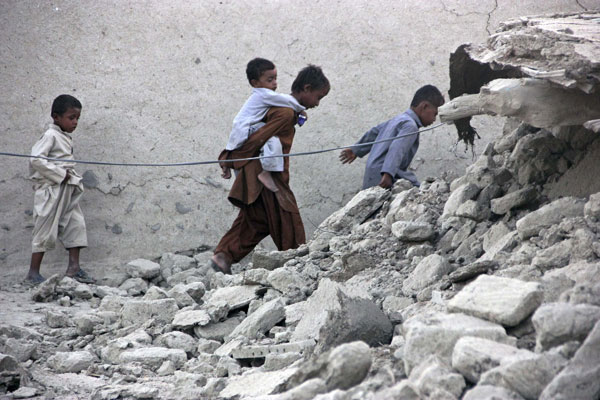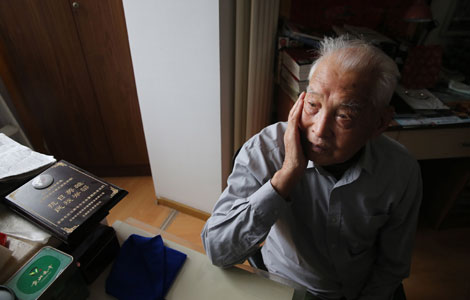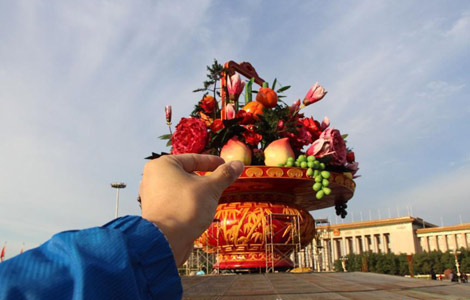208 killed in SW Pakistan earthquake
Updated: 2013-09-25 15:26
(Xinhua)
|
|||||||||||
 |
|
Survivors of an earthquake walk on rubble of a mud house after it collapsed following the quake in the town of Awaran, southwestern Pakistani province of Baluchistan, September 25, 2013. The death toll from a powerful earthquake in Pakistan rose to at least 208 on Wednesday after hundreds of mud houses collapsed on people in a remote area near the Iranian border, officials said. [Photo/Agencies] |
ISLAMABAD - A total of 208 people have been killed in a powerful earthquake that hit Pakistan's southwest province of Balochistan on Tuesday afternoon, said a local official Wednesday.
Jan Muhammad Buledi, spokesperson of Balochistan government, told the media that 145 people were killed in Awaran, the worst - hit area in the earthquake, and 63 died in the neighboring areas of Mashkai and Turbat. Local media said 395 people were also injured in the 7.7-magnitude earthquake.
The massive earthquake also reportedly flattened hundreds of houses in the earthquake-hit areas. Local media reports said over 90 percent of the mud houses in the affected areas were leveled to ground.
Rasheed Gadozai, deputy commissioner of Awaran, told local media that an estimated 100,000 people have been affected in Awaran.
Awaran is the poorest district in southern Balochistan with a population of less than 120,000.
The latest death toll figure announced by the country's top disaster management department, namely the National Disaster Management Authority (NDMA), is around 50, far below than what has been claimed by local officials.
An official with NDMA, when approached by Xinhua on the phone, said that they would give the updated figures after 10:00 am Wednesday.
The actual situation in the quake-hit areas is far from being clear at this point as many of the villages hit by the earthquake are hard to access, said Rasheed Gadozai.
The Balochistan government has declared emergency in the six quake-hit districts and has kicked off rescue operation in collaboration with the army and other security forces.
Earlier Wednesday morning, the Pakistani army sent another group of 600 soldiers to the quake-hit areas, bringing to 900 the total number of army personnel involved in the rescue operation, said army sources.
The first group of 300 soldiers dispatched Tuesday night to the quake-affected areas has reportedly set up a base camp in Khuzda, a district in central Balochistan located 120 kilometers northeast of the epicentre determined to be at 29.09 degrees north latitude and 65.61 degrees east longitude.
More troops could be sent to the quake-hit areas if situation turns serious, said army sources.
Local officials in Awaran said that one of the serious problems facing the rescue operation is the lack of doctors and medical facilities. Some of the people injured in the earthquake have been shifted to Karachi, they added.
The earthquake struck Aawarn and its neighboring districts at 4: 29 pm local time Tuesday. Pakistan Meteorological Department said that several aftershocks including one of 5.9 magnitude were recorded following the major quake and strong tremors were also felt in south Sindh and east Punjab provinces of the country.
Related Stories
Strong earthquake hits Fukushima, Japan 2013-09-20 19:11
5.1-magnitude earthquake rattles Urumqi 2013-08-31 08:30
Magnitude 6.8 earthquake shakes New Zealand 2013-08-16 11:35
Today's Top News
208 killed as quake hits SW Pakistan
China to inaugurate Shanghai FTZ on Sept 29
China expects to complete space station by 2023
China's investment a 'job-saver' in Europe
UN General Assembly starts debate
China aims to attract more foreign students
Company head admits bribe charges
Trending news across China
Hot Topics
Lunar probe , China growth forecasts, Emission rules get tougher, China seen through 'colored lens', International board,
Editor's Picks

|

|

|

|

|

|





